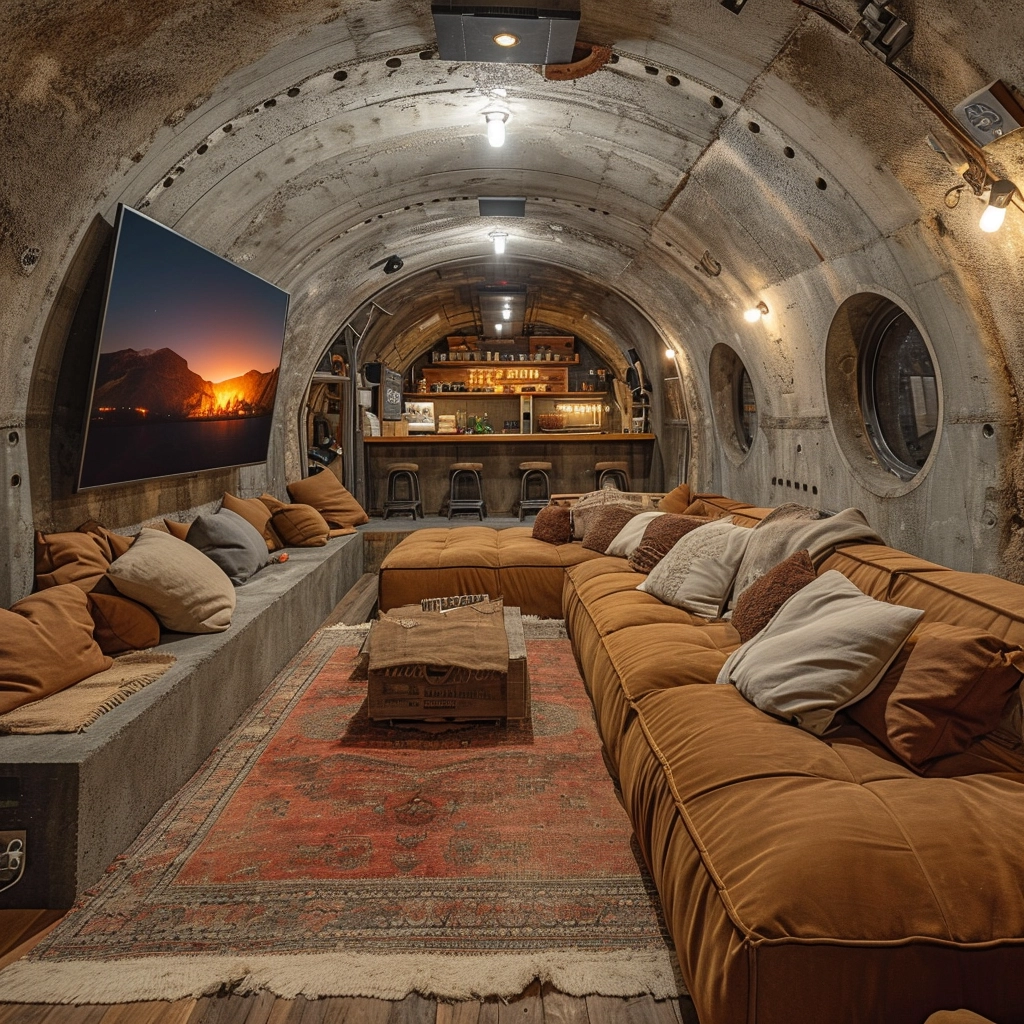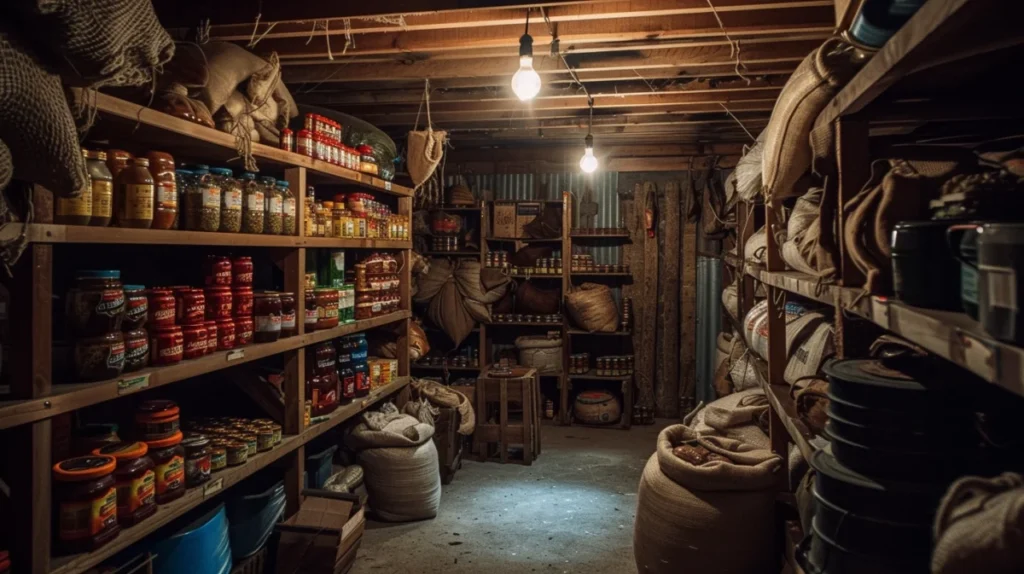In the world of preparedness, having a dedicated survival storage room is not just a luxury but a necessity.
This secure and organized space serves as a centralized hub for all your emergency supplies, gear, and rations, ensuring that you’re ready to face any potential crisis or disaster.
By creating a well-designed survival storage room, you’ll have peace of mind knowing that your essential items are easily accessible and protected.
Table of Contents
The Concept of a Survival Storage Room

When faced with an emergency situation, the last thing you want is to be scrambling to locate your crucial supplies.
A survival storage room solves this problem by providing a centralized location for all your preparedness items.
This dedicated space not only keeps everything organized and readily available but also helps protect your valuables from potential threats such as theft, fire, or environmental damage.
Moreover, having a designated storage area allows you to easily monitor and maintain your supplies, ensuring that you never run out of essential items when you need them most.
With a well-designed survival storage room, you’ll have peace of mind knowing that you’re truly prepared for whatever challenges may come your way.
Location and Security Considerations
Choosing the right location for your survival storage room is crucial.
Ideally, it should be a secure and discreet area within your home, such as a basement, spare room, or even a walk-in closet.
Consider the following factors when selecting the perfect spot:
- Security: Implement robust security measures, such as sturdy locks, concealment techniques, or even hidden entrances, to protect your supplies from potential intruders or thieves.
- Environmental Conditions: Ensure that the chosen location provides a stable temperature and humidity level, as extreme conditions can damage sensitive equipment or perishable items.
- Accessibility: While security is important, you’ll also need easy access to your supplies in case of an emergency. Consider the proximity to potential exit routes or safe rooms.
| Security Measure | Description |
|---|---|
| Reinforced Doors | Install heavy-duty doors with multiple locks or hidden entrances. |
| Concealment | Disguise or camouflage the storage room to avoid unwanted attention. |
| Climate Control | Install a dedicated HVAC system or dehumidifiers to maintain ideal conditions. |
Starter Action Steps:
- Assess potential locations within your home for a secure and discreet storage room.
- Research and budget for security measures, such as reinforced doors or concealment techniques.
- Evaluate the environmental conditions of potential locations and plan for climate control if necessary.
Shelving and Storage Solutions

Once you’ve chosen the perfect location, it’s time to focus on organizing your survival storage room.
Invest in sturdy and adjustable shelving units that can accommodate a wide range of items.
Consider the following tips for efficient storage:
- Categorize Items: Group similar items together, such as food, water, medical supplies, tools, and gear, for easy identification and retrieval.
- Clear Storage Containers: Utilize clear plastic bins or containers to store smaller items, allowing you to quickly identify their contents.
- Label Everything: Clearly label each container or shelf section to make it easier to locate specific items when needed.
Starter Action Steps:
- Measure the dimensions of your storage room and plan the layout for shelving units.
- Purchase heavy-duty shelving units that can support the weight of your supplies.
- Acquire clear storage containers and labels for better organization and visibility.
- Start grouping and categorizing your supplies for easy storage and retrieval.
Food and Water Storage
In any emergency scenario, ensuring a reliable supply of food and water is paramount.
Your survival storage room should be equipped with a well-stocked pantry and water storage system.
Follow these essential tips:
- Non-Perishable Foods: Stock up on shelf-stable, non-perishable foods with long expiration dates, such as canned goods, dehydrated meals, and grains.
- Rotation and Monitoring: Implement a system to rotate your food supply regularly, ensuring that older items are consumed first and replaced with fresh stock.
- Water Storage: Invest in high-quality water storage containers or tanks, and consider installing a water purification system for long-term water security.
| Item | Quantity | Expiration Date |
|---|---|---|
| Canned Beans | 50 cans | 2026 |
| Dehydrated Vegetables | 20 pouches | 2025 |
| Emergency Water Rations | 100 pouches | 2027 |
Starter Action Steps:
- Create a list of non-perishable foods to stock up on, prioritizing items with long shelf lives.
- Purchase food-grade water storage containers or tanks for long-term water supply.
- Establish a system for rotating and monitoring food and water supplies regularly.
- Consider investing in a water purification system for added security.
Medical and Hygiene Supplies
In times of crisis, access to medical care and personal hygiene products can be limited.
Ensure your survival storage room is well-stocked with essential supplies to maintain your health and well-being:
- First Aid Kits: Assemble comprehensive first aid kits with bandages, antiseptics, medications, and other medical supplies.
- Essential Medications: Store a backup supply of any essential medications you or your family members require, ensuring they are within their expiration dates.
- Personal Hygiene Items: Stock up on soap, toilet paper, feminine hygiene products, and other personal care items to maintain proper hygiene.
Starter Action Steps:
- Take inventory of your existing medical supplies and create a list of items to purchase or restock.
- Assemble a well-stocked first aid kit with a variety of bandages, antiseptics, and medications.
- Purchase backup supplies of essential medications for your family members.
- Stock up on personal hygiene items, such as soap, toilet paper, and feminine products.
Tools and Gear Storage

Your survival storage room should also serve as a centralized location for storing essential tools and gear.
Having these items readily available can make a significant difference in your ability to navigate and overcome various challenges:
- Hand Tools: Keep a supply of versatile hand tools, such as hammers, wrenches, pliers, and saws, for basic repairs and construction.
- Power Tools: If space permits, consider storing power tools like drills, saws, and generators, along with fuel and backup batteries.
- Camping and Outdoor Gear: Store tents, sleeping bags, cookware, and other camping equipment for potential evacuation or outdoor survival scenarios.
| Tool/Gear | Quantity | Condition |
|---|---|---|
| Camping Tent | 2 | New |
| Sleeping Bags | 4 | Used |
| Hand Tool Set | 1 | New |
| Portable Generator | 1 | Used |
Starter Action Steps:
- Make a list of essential hand tools and power tools you’ll need for repairs and construction.
- Acquire camping and outdoor gear, such as tents, sleeping bags, and cookware, for potential evacuation scenarios.
- Organize your tools and gear in a way that allows for easy access and identification.
- Ensure proper storage and protection from moisture, dust, and environmental factors.
Alternative Power and Lighting
In the event of a prolonged power outage, having alternative power sources and lighting options is crucial.
Your survival storage room should be equipped with the following:
- Generators and Fuel: Invest in a reliable generator and maintain a supply of fuel (gasoline, propane, or diesel) for backup power.
- Solar Panels and Batteries: Consider installing solar panels and battery banks for a renewable and sustainable power source.
- Emergency Lighting: Stock up on flashlights, lanterns, and battery-powered lighting options to illuminate your storage room and home during power outages.
Starter Action Steps:
- Research and purchase a reliable generator suitable for your power needs.
- Establish a safe storage and rotation system for generator fuel (gasoline, propane, diesel).
- Explore the possibility of installing solar panels and battery banks for renewable energy.
- Stock up on a variety of emergency lighting options, such as flashlights, lanterns, and battery-powered lights.
Documentation and Information Storage
In addition to physical supplies, your survival storage room should also serve as a secure repository for important documents and information.
Consider the following:
- Important Documents: Store copies of essential documents, such as passports, birth certificates, deeds, and insurance policies, in a waterproof and fireproof container.
- Survival Guides and Manuals: Keep a collection of survival guides, reference materials, and instructional manuals for various skills and scenarios.
- Digital Backup System: Maintain a digital backup of your important documents.
Starter Action Steps:
- Gather and make copies of essential documents (passports, birth certificates, deeds, insurance policies).
- Purchase a waterproof and fireproof container or safe for secure document storage.
- Compile a collection of survival guides, reference materials, and instructional manuals.
- Set up a digital backup system for important documents and information using external hard drives or cloud storage.
- Regularly update and organize your documentation and information storage.
Maintenance and Rotation
Maintaining and regularly updating your survival storage room is essential to ensure that your supplies remain in optimal condition and ready for use when needed.
Implement the following practices:
- Regular Inspections: Conduct periodic inspections of your storage room, checking for any signs of damage, moisture, or pests that could compromise your supplies.
- Rotation and Replacement: Establish a system for rotating perishable items, such as food and medications, and replace expired or damaged supplies promptly.
- Inventory Management: Maintain a detailed inventory of your supplies, noting expiration dates, quantities, and locations within your storage room.
Starter Action Steps:
- Schedule regular inspection dates for your survival storage room (e.g., monthly or quarterly).
- Create a system for rotating and replacing perishable items, such as food and medications.
- Develop an inventory management system, using spreadsheets or dedicated software, to track your supplies.
- Set reminders or alerts for expiration dates and restocking needs.
- Establish a routine for cleaning and reorganizing your storage room as needed.
Preparing for the Worst

While we hope never to face a true survival situation, it’s essential to be prepared for the worst.
Your survival storage room should be tailored to the specific threats and potential emergencies relevant to your location and circumstances:
- Natural Disasters: If you live in an area prone to earthquakes, hurricanes, or other natural disasters, stock supplies accordingly (e.g., emergency shelter, water purification tablets, etc.).
- Civil Unrest: In case of civil unrest or social upheaval, consider including self-defense items, communication devices, and supplies for sheltering in place.
- Pandemic Preparedness: Ensure you have adequate medical supplies, personal protective equipment, and provisions to sustain your household during a prolonged pandemic or quarantine.
Starter Action Steps:
- Research the potential threats and emergencies specific to your geographic location.
- Stock up on supplies tailored to those specific scenarios (e.g., emergency shelter, water purification, self-defense items).
- Ensure you have adequate medical supplies, PPE, and provisions for potential pandemics or quarantines.
- Develop emergency plans and practice drills with your family regularly.
- Stay informed about current events and potential risks in your area.
By creating a well-designed and organized survival storage room, you’ll be taking a crucial step towards ensuring your family’s safety and well-being in the face of any potential crisis or disaster.
Remember, preparedness is key, and having a centralized cache of essential supplies can make a significant difference when every second counts.
Conclusion
The creation of a well-designed survival storage room is a crucial step in ensuring your family’s preparedness for any potential crisis or disaster. By following the guidelines outlined in this article, you’ll be able to establish a centralized cache of essential supplies that can make a significant difference when every second counts.
To summarize, here are the key components of an effective survival storage room:
| Component | Summary |
|---|---|
| Location and Security | Choose a secure, discreet area with appropriate environmental conditions and access. Implement robust security measures. |
| Shelving and Storage Solutions | Invest in sturdy, adjustable shelving and clear storage containers. Categorize and label items for easy identification and retrieval. |
| Food and Water Storage | Stock up on non-perishable foods and have a reliable water storage and purification system. |
| Medical and Hygiene Supplies | Assemble first aid kits, store essential medications, and maintain personal hygiene items. |
| Tools and Gear Storage | Keep hand tools, power tools, and camping/outdoor gear readily available. |
| Alternative Power and Lighting | Have backup power sources (generators, solar panels) and emergency lighting options. |
| Documentation and Information | Store important documents, survival guides, and maintain digital backups. |
| Maintenance and Rotation | Regularly inspect, rotate perishables, and manage inventory. |
| Preparing for the Worst | Tailor your storage room to specific threats and potential emergencies in your area. |
Remember, preparedness is an ongoing process, and your survival storage room should be continuously maintained and updated to ensure its effectiveness.
By taking the necessary steps today, you’ll have the peace of mind knowing that you and your family are ready to face whatever challenges may come your way.


